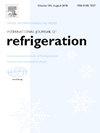Experimental and numerical investigation of a high-effectiveness cryogenic PCHE for space 80 K Brayton cryocooler
IF 3.5
2区 工程技术
Q1 ENGINEERING, MECHANICAL
International Journal of Refrigeration-revue Internationale Du Froid
Pub Date : 2025-04-16
DOI:10.1016/j.ijrefrig.2025.04.013
引用次数: 0
Abstract
Growing space cooling demand has made reverse Brayton cryocooler a promising technology, requiring higher effectiveness and lighter weight recuperative heat exchangers. This study proposes a novel cryogenic printed circuit heat exchanger (PCHE) design for an 80 K space Brayton cryocooler, with both high thermal performance and compactness. Unlike conventional PCHEs, the proposed cryogenic PCHE features high-density micro-fins (114 cm-2) and a thin wall (wall thickness of 0.1 mm), achieving a compactness of 4548 m2·m-3, 82 % higher than conventional designs. A counter-flow heat transfer model is developed, incorporating axial heat conduction effects typically overlooked in PCHE design models. Through systematic optimization, the cryogenic PCHE achieves a heat duty of 2.2 kW for gas neon between 80 K and 313 K, with compact core dimensions of 460 mm × 86 mm × 82 mm. Experimental testing demonstrated the exceptional performance of the cryogenic PCHE, achieving a heat transfer effectiveness of 97.3 %, surpassing conventional PCHEs, with only a 7.6 kPa total pressure drop. Compared to conventional plate-fin heat exchangers (PFHE) used in ground Brayton cryocoolers, the cryogenic PCHE shows superior performance. This design achieves a performance evaluation criterion of 1.8, while reducing 80 % volume requirements at equivalent thermal effectiveness. Additionally, the analysis reveals a 1.2 % effectiveness deterioration due to axial conduction, which leads to an 87.4 % overestimation of the cryocooler's cooling capacity, highlighting its significance in high-effectiveness cryogenic heat exchanger design.
空间80k布雷顿制冷机高效低温PCHE的实验与数值研究
日益增长的空间冷却需求使得逆布雷顿制冷机成为一项有前途的技术,它需要更高的效率和更轻的重量的回热式换热器。本研究提出了一种新型的低温印刷电路热交换器(PCHE)设计,用于80k空间布雷顿制冷机,具有高热性能和紧凑性。与传统PCHE不同,所提出的低温PCHE具有高密度微鳍(114 cm-2)和薄壁(壁厚0.1 mm),实现了4548 m2·m-3的致密性,比传统设计高82%。建立了一个逆流传热模型,其中包含了PCHE设计模型中通常忽略的轴向热传导效应。通过系统优化,低温PCHE在80k ~ 313k范围内实现了2.2 kW的气体氖气热负荷,核心尺寸紧凑,为460 mm × 86 mm × 82 mm。实验测试表明,低温PCHE具有优异的性能,传热效率达到97.3%,超过传统PCHE,总压降仅为7.6 kPa。与地面布雷顿制冷机中使用的传统板式翅片换热器(PFHE)相比,低温板式翅片换热器表现出优越的性能。该设计达到了1.8的性能评价标准,同时在等效热效率下减少了80%的体积要求。此外,分析显示,由于轴向传导导致1.2%的效率下降,这导致了对制冷机制冷量的87.4%的高估,突出了其在高效低温换热器设计中的重要性。
本文章由计算机程序翻译,如有差异,请以英文原文为准。
求助全文
约1分钟内获得全文
求助全文
来源期刊
CiteScore
7.30
自引率
12.80%
发文量
363
审稿时长
3.7 months
期刊介绍:
The International Journal of Refrigeration is published for the International Institute of Refrigeration (IIR) by Elsevier. It is essential reading for all those wishing to keep abreast of research and industrial news in refrigeration, air conditioning and associated fields. This is particularly important in these times of rapid introduction of alternative refrigerants and the emergence of new technology. The journal has published special issues on alternative refrigerants and novel topics in the field of boiling, condensation, heat pumps, food refrigeration, carbon dioxide, ammonia, hydrocarbons, magnetic refrigeration at room temperature, sorptive cooling, phase change materials and slurries, ejector technology, compressors, and solar cooling.
As well as original research papers the International Journal of Refrigeration also includes review articles, papers presented at IIR conferences, short reports and letters describing preliminary results and experimental details, and letters to the Editor on recent areas of discussion and controversy. Other features include forthcoming events, conference reports and book reviews.
Papers are published in either English or French with the IIR news section in both languages.

 求助内容:
求助内容: 应助结果提醒方式:
应助结果提醒方式:


